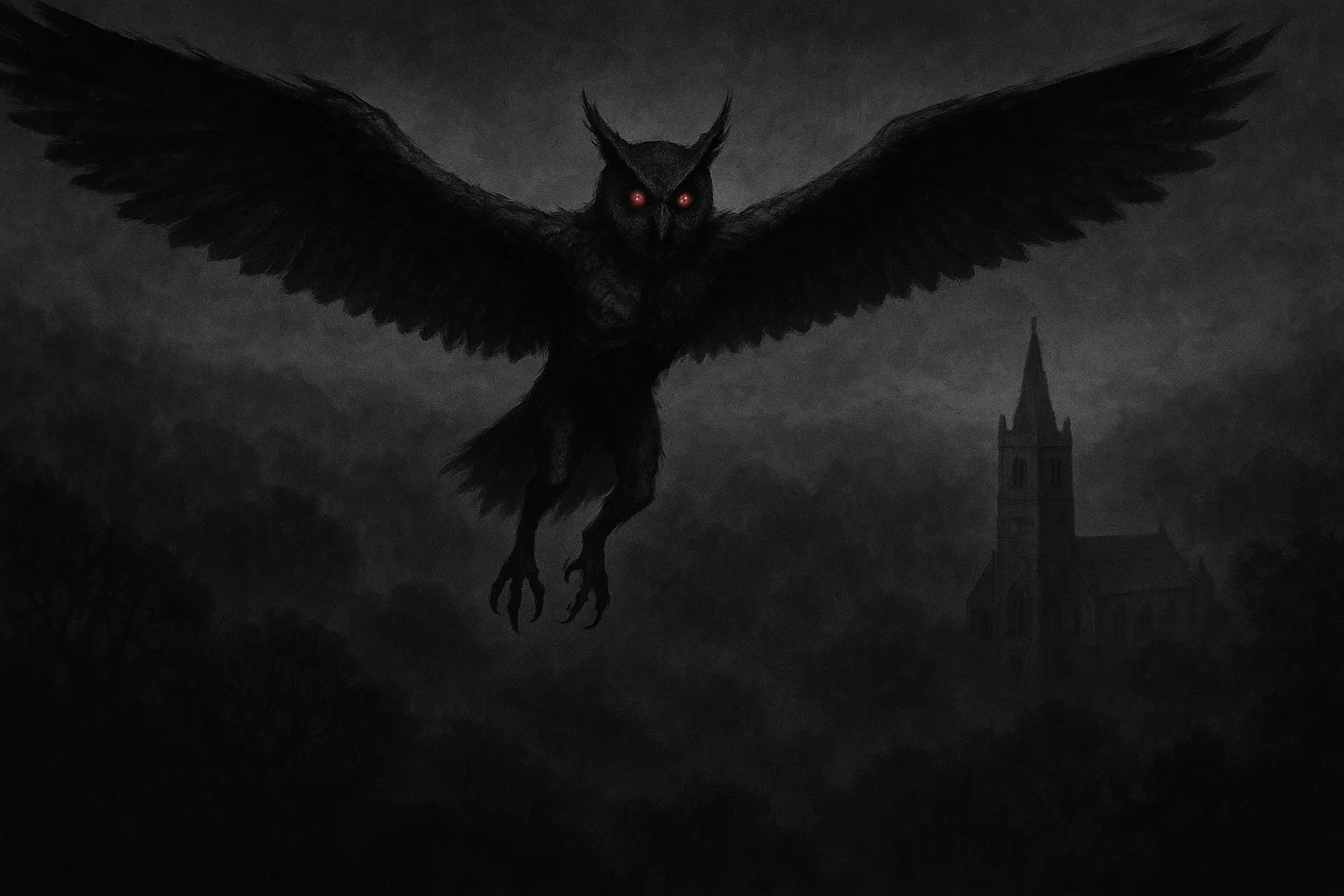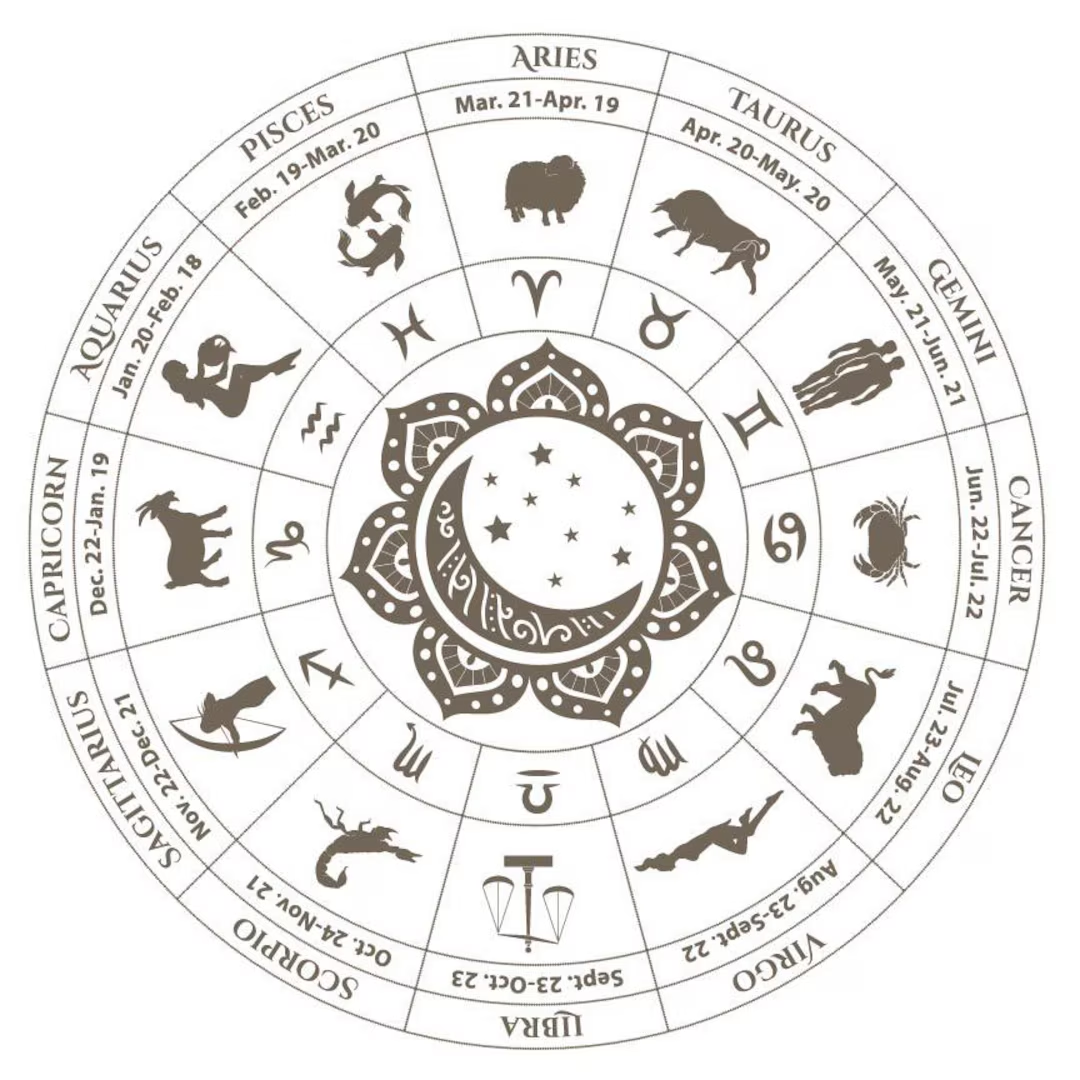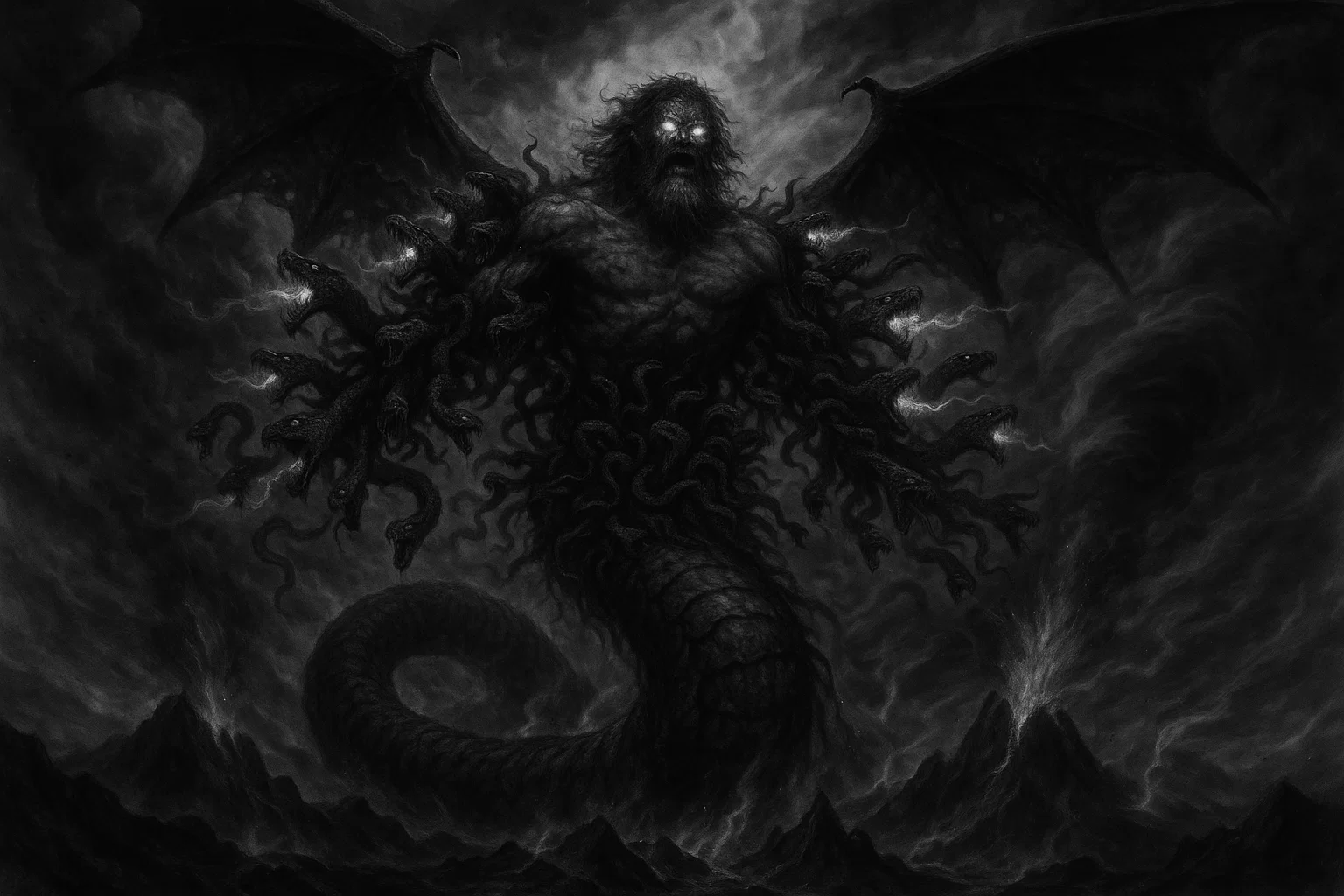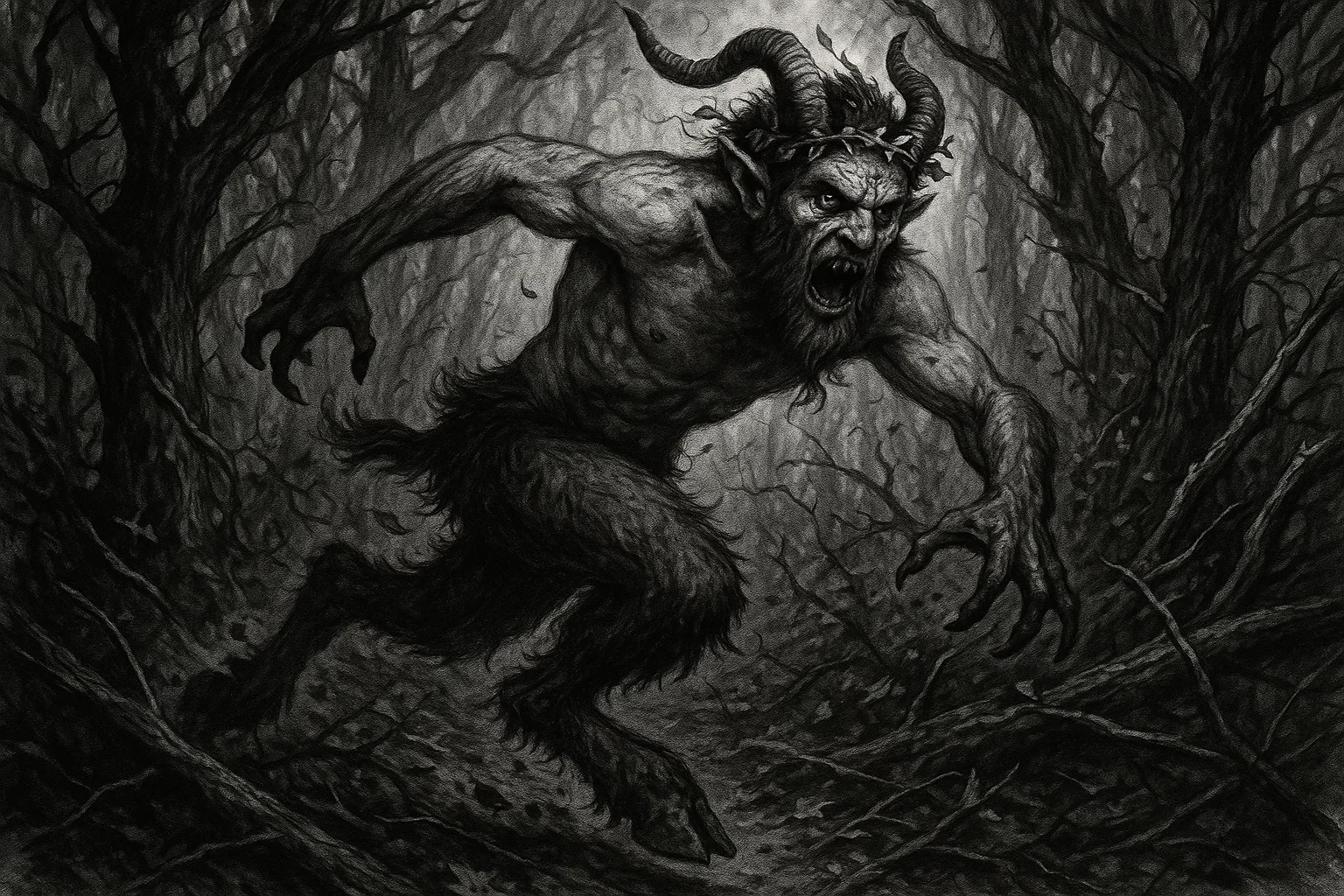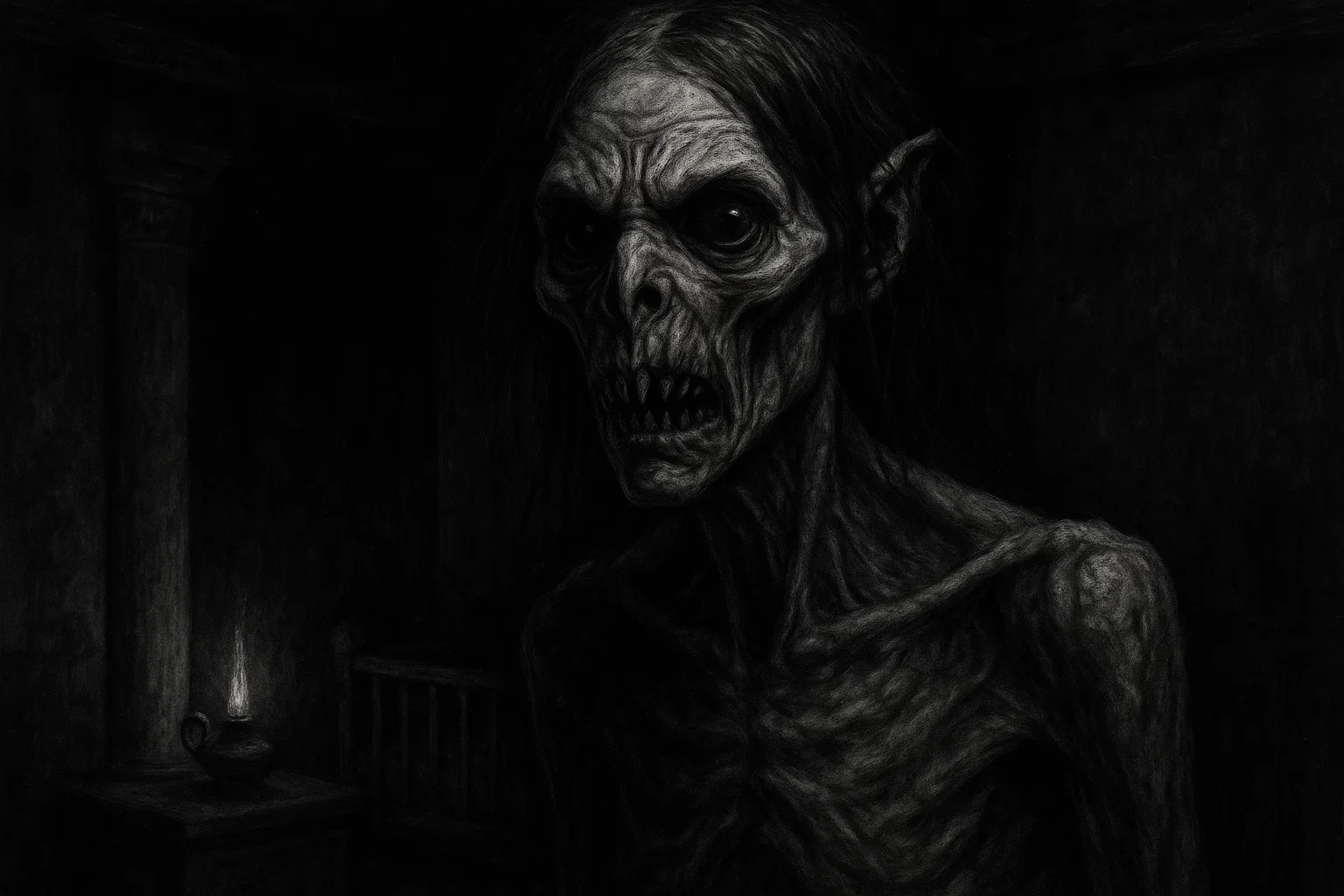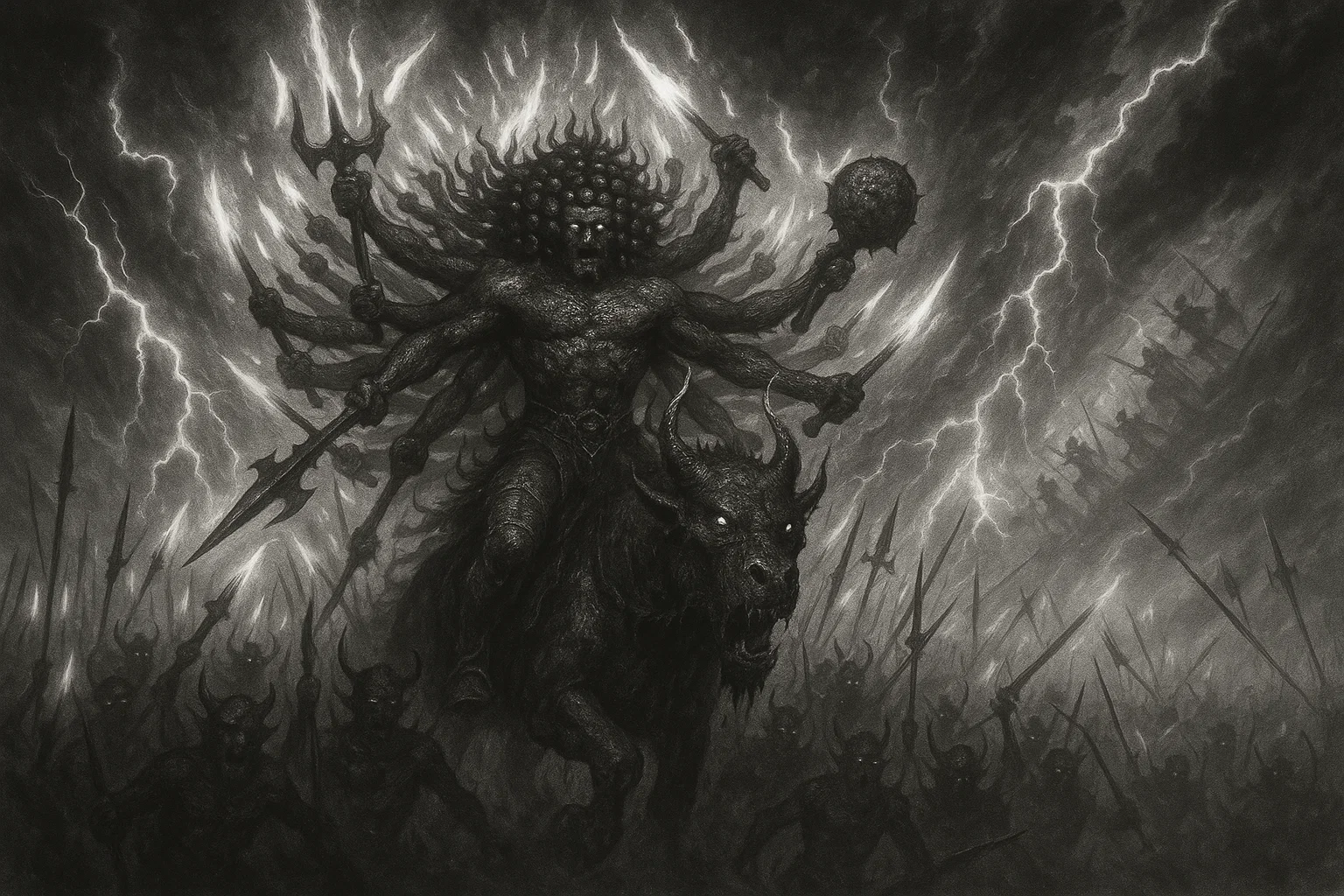The Owlman is a cryptid said to inhabit the region around the village of Mawnan Smith, Cornwall, United Kingdom. Often referred to as the Cornish Owlman or the Owlman of Mawnan, the creature gained modern notoriety following a series of sightings in 1976. Eyewitness reports typically describe an enormous, bipedal, owl-like humanoid with distinctive physical attributes.
Emerging into modern popular consciousness in the mid-1970s, the cryptid is typically described as a large, man-sized owl or avian-human hybrid with prominent, pointed ears, glowing red or black eyes, and sharp, pincer-like claws. Its legend is often compared to the American Mothman, both being winged humanoids whose sightings clustered around a specific period and location.
Summary
Overview
| Attribute | Details |
|---|---|
| Name | Owlman |
| Aliases | Owlman of Mawnan, Cornish Owlman, Death Raptor |
| Threat Level | Harmless; no reports of attacks or aggression toward humans |
| Habitat | Wooded areas and churchyards near Mawnan village, Cornwall, England; low-altitude rural terrain with dense foliage and coastal proximity |
| Physical Traits | Human-sized (approximately 5–6 feet tall); feathered body in black or silvery gray; large wings spanning 8–10 feet; red glowing eyes; backward-bending legs with pincer-like claws; owl-like head with pointed ears |
| Reported Sightings | Mawnan, Cornwall (St Mawnan and St Stephen’s Church, surrounding woods); sporadic reports in Mullion and nearby rural sites |
| First Documented Sighting | April 17, 1976 |
| Species Classification | Unknown; speculative avian humanoid or large undiscovered bird |
| Type | Airborne |
| Behavior & Traits | Nocturnal activity; silent hovering or flight; emits screeching or owl-like sounds; flees upon detection; associated with eerie lights or shadows |
| Evidence | Eyewitness accounts; unverified photographs; audio reports of calls |
| Possible Explanations | Misidentification of large owls or herons; local hoaxes involving costumes; psychological effects from folklore and environment |
| Status | Ongoing mystery; sightings rare after 1995 but legend persists in local culture |
Who or What Is the Owlman?
The Owlman is a cryptid reported in the rural landscapes of Cornwall, England, during the mid-1970s. It appeared as a focal point of local intrigue following multiple eyewitness reports of a winged, owl-resembling figure near historic sites.
Unlike traditional folklore beasts rooted in ancient tales, the Owlman’s documentation traces directly to modern accounts, beginning with children who described a bizarre aerial form. These narratives quickly spread through adult observations, attracting the attention of investigators interested in unexplained phenomena.
Classified broadly as an airborne anomaly, the Owlman shares traits with other winged humanoids but remains tied to its specific locale. Reports emphasize its sudden appearances at dusk or night, often near religious structures, which has led some to speculate about symbolic or supernatural origins.
Your Personalized, Hyper Accurate Moon & Astrology Reading
Limited time offer: Get your FREE, fully personalized Moon & Astrology Reading that takes astrology to a whole new level. Discover the secret depths of your personality, relationships, and true purpose in life.
What Does the Owlman Look Like?
Eyewitnesses consistently depict the Owlman as a bipedal, owl-like figure roughly the size of an adult human, standing about 5 to 6 feet tall when grounded.
Its body is covered in feathers, ranging from dark black to a shimmering silvery gray, with broad shoulders and a hunched posture that accentuates its avian form. The most striking feature is its head: a large, rounded owl visage with prominent, forward-facing eyes that emit a piercing red glow, suggesting either bioluminescence or reflective properties under low light.
Wings constitute another key trait, spanning 8 to 10 feet when extended, composed of dark, membranous or feathered surfaces capable of silent propulsion. The legs are notably bird-like, bending backward at the knees in a zygodactyl arrangement, terminating in sharp, pincer-shaped claws suitable for grasping.
Some accounts mention clawed hands or taloned feet, reinforcing the hybrid humanoid-avian design. The overall silhouette conveys a menacing yet ethereal quality, with pointed ear tufts and a beakless mouth that occasionally parts to reveal a hissing or screeching call.
Variations in color and detail across reports may stem from lighting conditions or observer distance. Still, the core form remains uniform as a feathered predator adapted for nocturnal flight.
You May Also Like: Siren: The Haunting Monster That Lured Sailors to Death
Habitat
The Owlman is mainly linked to the village of Mawnan, which is located in Cornwall, a beautiful coastal area in the southwest of England known for its mild weather.
Mawnan lies along the River Helford and has gently rolling hills that rarely go over 200 feet in height. The landscape is filled with old oak trees, hazel bushes, and ferns, creating dense, misty forests that provide plenty of hiding spots for mysterious creatures. The area also has rocky outcrops and narrow lanes that can be dark and difficult to navigate at night.
The local wildlife includes common British birds such as tawny owls and herons, as well as small mammals like badgers and foxes. This mix of animals creates a natural setting where large birds of prey, like the Owlman, could live without being easily seen.
A key spot for sightings of the Owlman is St Mawnan and St Stephen’s Church, a 15th-century building that stands on a hillside overlooking the village. The church has a tower covered in ivy and a graveyard that often gets shrouded in fog during the frequent drizzles in the area. Many reports of the Owlman come from people who have seen it hovering above the church or resting nearby.
The proximity to the sea brings salty winds and changing tides, creating a humid environment that is perfect for nighttime activity.
Because people live far apart in this area—mostly on scattered farms and holiday cottages—there are fewer disturbances, which adds to the sense of isolation for anyone who might witness the creature. Although sightings occur in other nearby rural areas, like Mullion, most reports are centered on Mawnan.
This pattern of sightings suggests that the Owlman may have a specific territory, possibly connected to the church’s old pagan history, or suitable places to roost in the trees.
Owlman Sightings
| Date | Place | Witness Details | Description | Reliability |
|---|---|---|---|---|
| April 17, 1976 | Mawnan church tower | Two young girls (ages 9 and 12, unnamed initially) | Large owl-like figure hovering silently 40 feet above the tower; feathered body, red eyes | Medium: Multiple child witnesses, no corroboration |
| May 1976 | Woods near Mawnan church | Single young girl (age unspecified) | Silvery gray creature with pincers on legs; emitted screeching sound | Low: Single witness, vague details |
| June 1976 | Mawnan woods | Two boys (ages 10–12) | Black-winged humanoid flying low through trees; glowing eyes visible at dusk | Medium: Multiple witnesses, reported via intermediary |
| June 13, 1976 | Near Mawnan churchyard | Adult man (identity withheld) | Owlman perched on church wall; backward-bending legs noted; fled upward | Low: Single adult, anonymous report |
| July 3, 1976 | Woods by Mawnan church | Sally Chapman (14) and Barbara Perry (13) | Human-sized owl with claws; hovered menacingly before flying off | High: Detailed child accounts, consistent with prior |
| August 1976 | Mawnan vicinity | Man and woman (couple, unnamed) | Feathered entity in underbrush; red eyes and wings folded like a bat | Medium: Two adults, partial visibility |
| September 1976 | Rural path near Mawnan | Local resident (male, age 20s) | Shadowy flying form with owl call; pursued briefly but escaped | Low: Single witness, nighttime conditions |
| 1978 | Above Mawnan church tower | Multiple locals (group sighting) | Owlman hovering ominously; emitted loud screech; visible for several minutes | Medium: Group observation, no photos |
| 1979 | Mullion churchyard | Unnamed witness (adult) | Silvery figure landing near graves; claws scraping stone | Low: Isolated report, minimal details |
| 1989 | Woods outside Mawnan | Young couple (both in 20s) | Large winged creature with backward knees; chased them briefly before flying | High: Two adults, physical pursuit element |
| 1995 | Near Mawnan church | Hiker (solo male, age 30s) | Owl-like shadow with red glow; heard flapping wings depart | Medium: Single but detailed sensory account |
Two Young Girls (Mawnan Church Tower, April 17, 1976)
The story of the Owlman begins on a spring evening when two sisters, aged 9 and 12, were exploring near St Mawnan and St Stephen’s Church during a family trip.
While they were outside, they looked up and saw something strange hovering about 40 feet above the church tower. It looked like a large, feathered creature with wide wings and bright red eyes, staring right at them.
Frightened, the girls ran back to their parents, but they brushed off the story as something the girls had made up. However, after that night, people in the area began sharing similar stories of strange sightings. Though there were no pictures of the creature, the sisters’ consistent descriptions over the years made others take their claims seriously.
Later, investigators noted that the church is situated on a quiet hilltop, which would provide a good spot for something unusual to hover without wind, causing any movement.
Awaken XT is unlike anything you’ve ever tried before…
…it’s based off a closely guarded formula that’s said to be able to supercharge your pineal gland and help you access your untapped inner power. With it’s unique blend of extremely hard to source ingredients, Awaken XT helps support the healthy functioning of your pineal gland, as well as your other organs in your body.
Sally Chapman and Barbara Perry (Mawnan Woods, July 3, 1976)
In the summer of 1976, two friends, 14-year-old Sally Chapman and 13-year-old Barbara Perry, had an incredible encounter while camping in the woods near a church. As night began to fall, they heard strange noises coming from the trees.
Turning around, they saw a mysterious creature sitting on a low branch. It looked something like an owl, with gray feathers that blended into the fog surrounding it.
The creature was about the same height as a person and had tufted ears, a flat face, and legs that bent oddly, ending in black claws that clicked against the tree bark. Its bright red eyes glowed in the dark, revealing the delicate details of its feathers as it tilted its head to look at them.
When their eyes met, the creature let out a chilling scream that sounded like a mix of an owl hoot and a human wail. Then, with powerful wings, it took off into the sky.
After their sighting, Sally and Barbara reported what they saw to the authorities and the media, sharing their drawings of the creature. Their descriptions matched earlier sightings, which helped attract more attention to the strange phenomenon.
You May Also Like: What Are the Teihiihan—the Cannibal Dwarves of the Great Plains?
Young Couple (Woods Outside Mawnan, 1989)
More than ten years later, a young couple in their twenties sparked interest in the Owlman during a late-night stroll near Mawnan. After leaving a pub, they took a wooded path when, suddenly, they felt a rush of air and saw the creature descend from the trees above.
It was tall, with a shiny black body and large wings that were partly folded. Its clawed feet touched the ground as it moved closer, and its bright red eyes glowed in the moonlight. When the couple shouted in fear, the Owlman quickly took off into the sky.
Unlike previous sightings, this one felt like a chase, making the experience even more frightening for them. They reported what they saw to local newspapers, and their consistent stories, along with the fact that they weren’t famous, caught people’s attention.
Although no one was hurt, the incident brought back memories of similar sightings from 1976, indicating that the Owlman might still be around.
Evidence & Investigations
The existence of the Owlman is mostly supported by personal stories from people who claim to have seen it. These accounts date back to 1976 and continue through 1995, with more than a dozen people describing similar features, such as its size, color, and flying abilities, despite coming from different age groups, including children and adults.
Many witnesses have reported hearing strange screeching noises from quite a distance. However, these sounds have never been scientifically analyzed to determine which bird might produce them. Attempts to capture clear photos of the Owlman have not been successful.
For instance, in 1976, a man named Tony “Doc” Shiels, who called himself a warlock, claimed he took blurry pictures of a winged figure near a church during a staged event. However, these images have been criticized because Shiels had a reputation for fabricating stories.
Shiels was the first to investigate the Owlman sightings formally. He spoke to witnesses and shared their stories in local newspapers like the Falmouth Packet. His strong involvement led some people to suspect he might be creating hoaxes, given his background as a magician, although he denied it.
In the 1990s, Jonathan Downes of the Centre for Fortean Zoology also investigated the Owlman claims, visiting relevant locations and gathering stories from locals. Although his team didn’t find any actual evidence of the creature, they did record ongoing local tales, including reports of strange lights in a churchyard from the 1980s.
Cryptozoologists, or scientists who study mythical creatures, like Karl Shuker, have included the Owlman in their research on winged humanoids, comparing it with similar stories from around the world. However, they point out that there is no physical evidence, such as tracks or feathers, that could confirm the Owlman’s existence.
Skeptics, such as those from the Cornish Wildlife Trust, have searched for large birds in the area but have only found common species, such as Eurasian eagle-owls, which are similar in size but lack human-like features.
Since 1995, sightings of the Owlman have mostly turned into anecdotes. Overall, while the stories about the Owlman are consistent and compelling, they do not provide solid proof, leaving the creature as a fascinating mystery in local folklore rather than a confirmed reality.
Theories
Misidentification of Escaped or Native Avifauna
One popular theory suggests that the sightings of the Owlman may actually be cases of mistaken identity involving large birds found in or brought to Cornwall.
The Eurasian eagle-owl is the largest owl in Europe, boasting a huge wingspan of about 6 feet and striking yellow eyes that might appear red under certain lighting. This owl’s size and quiet flying style match many descriptions of the Owlman.
Historical records from the 1970s show that some of these owls escaped from private collections, which could explain why people have seen them near human-populated areas, especially when they are confused and searching for places to rest, such as church towers or wooded areas.
Witnesses often describe the Owlman as having a “humanoid” shape, which might be due to how our night vision works. In dim lighting or fog, the outline of a perched owl can look like a person standing up.
Additionally, the owl’s vocalizations and flying behavior may resemble what people report during Owlman sightings, and other birds, like herons or buzzards, could also be mistaken for the Owlman due to their slimmer profiles.
Local birdwatchers have noted similar cases of people misidentifying large owls for ghosts, connecting a surge of sightings in 1976 to seasonal bird migrations and heightened media attention at the time.
You May Also Like: The Nimerigar: Cannibalistic Little People of the Rocky Mountains
Occult Summoning Tied to Local Artists
Another theory suggests that the mysterious Owlman may be linked to the unintentional actions of some 20th-century occultists, particularly two artists, Mary E. Comfort Ernst and Wallace A. Carrington.
In the 1930s, they lived near Mawnan and had a strong interest in bird symbolism. Ernst created paintings featuring owls, while Carrington produced sketches that seemed to involve rituals. They often conducted private ceremonies that mixed local pagan traditions with beliefs from a spiritual movement known as Thelema.
Supporters of this theory believe that their activities in the nearby woods, near an ancient church, may have stirred up energies that led to the appearance of the Owlman.
This notion is similar to the idea of creating a “thought-form,” where intense focus and belief can bring something into existence. Interestingly, the first public sightings of the Owlman were reported about 40 years after Ernst and Carrington’s most active period, aligning with traditional beliefs about karma and mysterious events occurring around solstices.
Additionally, a figure known as Shiels, who styled himself as a warlock and promoted these sightings, may have amplified the phenomenon unintentionally by echoing the energies left behind by Ernst and Carrington.
Psychological Projection in Isolated Environments
Environmental psychology suggests that the community’s mindset could influence the sightings of the Owlman in Mawnan. The town’s isolation allows people to see shapes and patterns in everyday objects—a phenomenon known as pareidolia—that can amplify local legends.
Mawnan’s Celtic background, filled with stories of shapeshifting spirits like the Bucca, makes residents more likely to interpret unusual happenings—especially during the challenging economic times of the 1970s, when anxiety was high.
Initially, reports from children about the Owlman were sensationalized by local journalist Tony Shiels, creating a cycle in which people began to expect to see something extraordinary. As they wandered into the dark woods, they began to interpret ordinary sights—such as shadows and glowing fungi—as signs of the cryptid.
This is similar to what happens during UFO sightings, where people misinterpret regular sights—like swaying tree branches or bats flying—thinking they’re seeing something strange.
The vivid description of the Owlman often includes red eyes, which may simply be reflections from a flashlight. The idea of backward legs could stem from how people perceive things from a low angle, which can create optical illusions.
Overall, this theory helps explain why the sightings peaked in 1976 and quickly faded as people lost interest, without needing any external factors to blame.
You May Also Like: What Is a Pukwudgie? Spirit, Cryptid, or Something Worse?
Extraterrestrial or Interdimensional Scout
Some researchers of unidentified flying objects (UFOs) suggest that the Owlman could be an alien scout sent to observe us, similar to how some people describe encounters with aliens, in which they see familiar forms rather than the actual beings.
In Cornwall, certain rock formations and ancient burial sites are believed to serve as gateways that allow travel between dimensions. Some think that churches in the area might play a key role because of their old stone foundations.
Many sightings of the Owlman happen at night, with reports of the creature appearing suddenly and then disappearing just as quickly, similar to other mysterious phenomena experienced in the region, such as unexplained flying lights during the 1970s.
Supporters of the Owlman theory point to photographs taken by a man named Shiels as possible evidence of strange energy in the area, and suggest that the creature’s unique claws could help it travel across different realities.
These ideas are often discussed in less mainstream publications, which view the Owlman as a sign that we might be on the brink of more significant interactions with unnatural beings. However, there isn’t much solid evidence to support it.
Comparison with Other Similar Cryptids
| Cryptid | Region | Physical Traits | Behavior | First Sighting | Status |
|---|---|---|---|---|---|
| Mothman | West Virginia, USA | 7-ft winged humanoid; red eyes; moth wings | Nocturnal flights; omens | 1966 | Ongoing legend |
| Spring-heeled Jack | London, England | Spring-loaded legs; clawed hands; bat cape | Leaps buildings; assaults | 1837 | Historical, sporadic |
| Batsquatch | Washington State, USA | 8-ft bat-man; leathery wings; white fur | Aerial dives; territorial | 1994 | Rare reports |
| Thunderbird | Pacific Northwest, USA | Massive raptor; 20-ft wingspan; eagle-like | Storm-summoning flights | 1890 | Folklore-based |
| Van Meter Visitor | Iowa, USA | Horned winged being; glowing eyes | Nocturnal hovers; beams | 1903 | Isolated wave |
| Popobawa | Zanzibar, Tanzania | One-eyed bat-man; shapeshifting | Night attacks; invisible | 1972 | Cultural panic |
| Ahool | Java, Indonesia | Giant bat-owl; 10-ft wings; screech | Forest glides; elusive | 1927 | Unverified |
| Ropen | Papua New Guinea | Pterosaur-like; bioluminescent tail | Coastal flights; glowing | 1930s | Expedition target |
| Chupacabra (winged variant) | Puerto Rico | Reptilian hopper; leathery wings | Livestock predation | 1995 | Debunked mutations |
| Mogollon Monster | Arizona, USA | Winged ape-man; furred; muscular | Mountain roams; howls | 1903 | Trail cam claims |
| Indrid Cold | West Virginia, USA | Grinning winged alien; silver suit | Vehicle pursuits; telepathy | 1966 | UFO-linked |
| Flatwoods Monster | West Virginia, USA | 10-ft tall; claw hands; floating | Emits gas; mechanical | 1952 | Meteor misID |
You May Also Like: Is the Lake Iliamna Monster Alaska’s Real-Life Sea Cryptid?
Is Owlman Real?
The story of the Owlman is built on mysterious sightings reported by people in a beautiful area of Cornwall. These accounts, while intriguing, come without solid proof.
Investigators often point to more ordinary explanations, like mistaken identities with birds or stories that have been exaggerated over time. Still, the details and timing of these sightings make it hard to dismiss them completely.
Culturally, the Owlman adds to Cornwall’s rich history of mysteries, inspiring art, tours, and a sense of wonder while reminding us not to jump to conclusions as we wander through dark woods.

